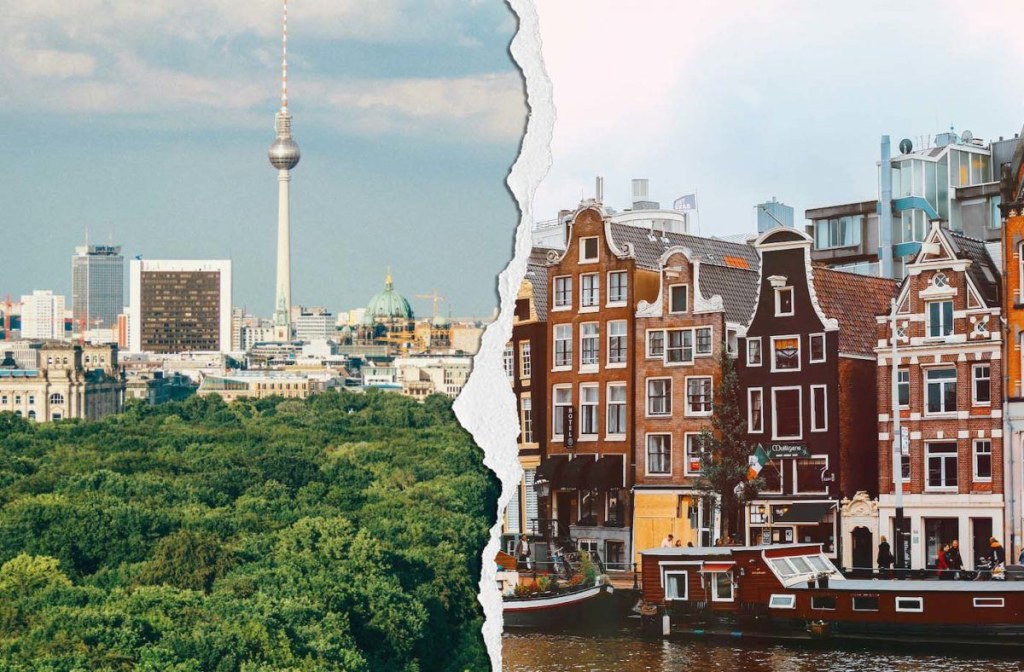Unveiling The Ultimate Showdown: Amsterdam Vs Berlin – Which City Steals The Spotlight?
Amsterdam vs Berlin: A Comparison of Two Iconic European Cities
Introduction
Hello Berlin Visitors,
2 Picture Gallery: Unveiling The Ultimate Showdown: Amsterdam Vs Berlin – Which City Steals The Spotlight?


Welcome to this comprehensive article where we will delve into the intriguing comparison between two iconic European cities: Amsterdam and Berlin. These cities have captivated travelers from around the world with their rich culture, historical significance, and vibrant urban landscapes. In this article, we will explore various aspects of both cities, including their attractions, local culture, nightlife, transportation, and more. Whether you are planning a trip or simply curious about these two remarkable destinations, this article will provide valuable insights to help you make informed decisions. So let’s embark on this exciting journey to discover the unique characteristics of Amsterdam and Berlin!
Table: A Brief Comparison of Amsterdam and Berlin

Image Source: reason-why.berlin
Amsterdam
Berlin
Country
Netherlands
Germany
Population
Approximately 865,000
Approximately 3.8 million
Main Language
Dutch
German

Image Source: orange-quarter.com
Climate
Maritime
Continental
Currency
Euro (€)
Euro (€)
Time Zone
Central European Time (CET)
Central European Time (CET)
What Makes Amsterdam and Berlin Unique?
Amsterdam and Berlin are both renowned for their distinct characteristics that set them apart from other European cities. In Amsterdam, the city’s picturesque canals, historic architecture, and world-class museums make it a favorite among art enthusiasts and history buffs. On the other hand, Berlin’s vibrant street art scene, diverse neighborhoods, and turbulent history make it a fascinating destination for those seeking a blend of culture and modernity.
Amsterdam: A City of Canals and Culture
Amsterdam is famous for its intricate canal system, which has earned it the nickname Venice of the North. The city’s charming canals, lined with beautiful 17th-century houses, create a picturesque setting that is a delight to explore. Additionally, Amsterdam boasts an impressive array of museums, including the world-renowned Rijksmuseum and the Van Gogh Museum, which house priceless artworks from famous Dutch masters.
Berlin: A City of History and Creativity
Berlin, on the other hand, offers a unique blend of history and creativity. The city’s tumultuous past is palpable as you walk through remnants of the Berlin Wall and visit iconic landmarks such as the Brandenburg Gate. Berlin also embraces its reputation as a hub for artists and creatives, with vibrant neighborhoods like Kreuzberg and Friedrichshain offering a dynamic mix of street art, trendy cafes, and eclectic shops.
Who Should Visit Amsterdam and Berlin?
Both Amsterdam and Berlin attract a diverse range of travelers, each offering something unique for different interests and preferences.
Amsterdam is ideal for art enthusiasts, history lovers, and those seeking a romantic and picturesque city. With its world-class museums, historic sites, and serene canals, Amsterdam provides a cultural and immersive experience.
Berlin, on the other hand, appeals to those interested in history, urban exploration, and vibrant nightlife. The city’s rich history, thriving art scene, and legendary nightlife make it a haven for creatives and party-goers alike.
When is the Best Time to Visit?
The best time to visit Amsterdam and Berlin largely depends on your preferences and what you aim to experience.
Amsterdam experiences mild summers and cold winters. The peak tourist season is during the summer months (June to August) when the weather is pleasant and outdoor activities flourish. However, this also means larger crowds and higher prices. Spring (April to May) and autumn (September to October) offer mild weather and fewer tourists, making it an ideal time to visit if you prefer a more relaxed atmosphere.
Berlin, being a dynamic city, can be enjoyed all year round. The summer months bring festivals, outdoor events, and a lively atmosphere. Winter in Berlin is known for its Christmas markets and cozy atmosphere. Spring and autumn provide milder weather, making it ideal for exploring the city on foot.
Where to Stay in Amsterdam and Berlin?
Both Amsterdam and Berlin offer a wide range of accommodation options to suit various budgets and preferences.
In Amsterdam, the city center is a popular choice for tourists, with its proximity to major attractions and picturesque canals. The Jordaan and De Pijp neighborhoods are also desirable areas, known for their charming streets, boutique shops, and cozy cafes. For those seeking a more budget-friendly option, hotels and guesthouses outside the city center offer affordable alternatives.
In Berlin, the choice of neighborhoods depends on your interests and preferred atmosphere. Mitte, the city center, is ideal for first-time visitors, as it is close to major landmarks and offers a vibrant atmosphere. Kreuzberg and Friedrichshain are popular among artists, young travelers, and those seeking a lively nightlife scene. Prenzlauer Berg, on the other hand, is known for its laid-back vibe, trendy cafes, and parks.
Why Visit Amsterdam and Berlin?
There are numerous reasons why Amsterdam and Berlin should be on every traveler’s bucket list.
Amsterdam’s unique combination of historic charm, world-class museums, and picturesque canals offers a truly immersive and romantic experience. From strolling along the canal banks to exploring the vibrant neighborhoods, Amsterdam is a city that appeals to all the senses.
Berlin, on the other hand, captures the spirit of a city constantly reinventing itself. Its rich history, vibrant arts scene, and diverse neighborhoods make it an incredibly dynamic destination. Whether you’re exploring the remnants of the Berlin Wall or enjoying the bustling nightlife, Berlin has an energy that is hard to match.
How to Get Around Amsterdam and Berlin?
Both Amsterdam and Berlin offer efficient and reliable public transportation systems, making it easy to navigate the cities.
In Amsterdam, the most popular mode of transportation is cycling. The city is known for its extensive network of bike paths, making it a cyclist’s paradise. For longer journeys, trams, buses, and the metro are also available, providing convenient options for exploring the city and its surroundings.
Berlin has an extensive public transportation network consisting of trams, buses, and the U-Bahn and S-Bahn trains. The city is well-connected, and tickets can be purchased for various durations, allowing for unlimited travel within specific zones.
Advantages and Disadvantages of Amsterdam and Berlin
Advantages of Amsterdam:
1. Rich cultural heritage with world-class museums and historic sites. 🏛️
2. Picturesque canals and charming architecture. 🌆
3. Bicycling-friendly infrastructure. 🚲
4. Cosmopolitan atmosphere with a tolerant and diverse population. 🌍
5. Accessible location within Europe. ✈️
Disadvantages of Amsterdam:
1. High tourist crowds, especially during peak season. 🌆
2. Limited space leading to higher accommodation and living costs. 💰
3. Potential language barrier for non-Dutch speakers. 🗣️
4. Strict regulations and policies, particularly concerning cannabis and tourism. 🚫
5. Weather can be unpredictable, with frequent rainfall. ☔
Advantages of Berlin:
1. Rich history and cultural significance. 🏰
2. Dynamic arts and music scene. 🎭🎵
3. Affordable cost of living compared to other European cities. 💸
4. Vibrant and diverse neighborhoods. 🌈
5. Lively nightlife and entertainment options. 🎉
Disadvantages of Berlin:
1. Cold winters and relatively short summers. ❄️
2. Potential language barrier for non-German speakers. 🗣️
3. The city’s size can be overwhelming for some visitors. 🌆
4. Occasional pockets of graffiti and urban decay. 🎨
5. Limited green spaces in some areas. 🌳
Frequently Asked Questions about Amsterdam and Berlin
1. Is Amsterdam or Berlin more bike-friendly?
Amsterdam is known as one of the most bike-friendly cities in the world, with an extensive network of bike paths. While Berlin also has a significant cycling culture, Amsterdam’s infrastructure and bike-friendly initiatives make it the preferred choice for cyclists.
2. Which city has a better nightlife: Amsterdam or Berlin?
Both cities have vibrant nightlife scenes, but Berlin is often considered the party capital of Europe. With its countless clubs, bars, and music venues, Berlin offers a diverse and energetic nightlife that caters to all tastes.
3. Are there any day trips or excursions from Amsterdam and Berlin?
Yes, both Amsterdam and Berlin offer a variety of day trip options. From Amsterdam, you can explore the picturesque countryside of the Netherlands, visit iconic windmills in Kinderdijk, or take a boat tour to the charming village of Marken. Berlin, on the other hand, offers opportunities to visit nearby destinations such as Potsdam, known for its palaces and gardens, or the historic city of Dresden.
4. Can I visit Amsterdam and Berlin in one trip?
Yes, it is possible to combine a visit to both cities in one trip, as they are relatively close to each other. A train journey between Amsterdam and Berlin takes around 6 hours, offering an opportunity to experience the contrasting landscapes of the Netherlands and Germany. However, it is recommended to allocate sufficient time to fully explore and appreciate each city.
5. Which city offers more opportunities for art and culture?
Both Amsterdam and Berlin have thriving art and cultural scenes. Amsterdam’s world-class museums, such as the Rijksmuseum and the Van Gogh Museum, house priceless artworks that attract art enthusiasts from around the world. Berlin, on the other hand, is known for its alternative art spaces, street art, and contemporary galleries. The city’s vibrant arts scene makes it a hub for artists and creatives.
Conclusion: Experience the Best of Amsterdam and Berlin
As we conclude this comparison between Amsterdam and Berlin, it is evident that both cities offer unique and captivating experiences. Whether you are drawn to Amsterdam’s picturesque canals and rich cultural heritage or Berlin’s vibrant street art and historical significance, these cities have much to offer. So, plan your trip, immerse yourself in the local culture, explore the diverse neighborhoods, and create unforgettable memories. Amsterdam and Berlin await your discovery!
Final Remarks
Disclaimer: The information provided in this article is based on research and personal experiences. It is always recommended to check the latest travel advisories and guidelines before planning your trip. The opinions expressed in this article are those of the author and may differ from individual experiences. Enjoy your journey to Amsterdam and Berlin!
This post topic: Berlin



